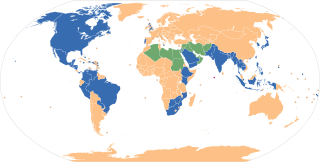Related Research Articles
The Julian calendar is a solar calendar of 365 days in every year with an additional leap day every fourth year. The Julian calendar is still used as a religious calendar in parts of the Eastern Orthodox Church and in parts of Oriental Orthodoxy as well as by the Amazigh people.
A leap year is a calendar year that contains an additional day compared to a common year. The 366th day is added to keep the calendar year synchronised with the astronomical year or seasonal year. Since astronomical events and seasons do not repeat in a whole number of days, calendars having a constant number of days each year will unavoidably drift over time with respect to the event that the year is supposed to track, such as seasons. By inserting ("intercalating") an additional day—a leap day—or month—a leap month—into some years, the drift between a civilization's dating system and the physical properties of the Solar System can be corrected.

The New Year is the time or day at which a new calendar year begins and the calendar's year count increments by one. Many cultures celebrate the event in some manner. In the Gregorian calendar, the most widely used calendar system today, New Year occurs on January 1. This was also the first day of the year in the original Julian calendar and the Roman calendar.

A week is a unit of time equal to seven days. It is the standard time period used for short cycles of days in most parts of the world. The days are often used to indicate common work days and rest days, as well as days of worship. Weeks are often mapped against yearly calendars.

Year 772 (DCCLXXII) was a leap year starting on Wednesday of the Julian calendar. The denomination 772 for this year has been used since the early medieval period, when the Anno Domini calendar era became the prevalent method in Europe for naming years.
AD 82 (LXXXII) was a common year starting on Tuesday of the Julian calendar. At the time, it was known as the Year of the Consulship of Augustus and Sabinus. The denomination AD 82 for this year has been used since the early medieval period, when the Anno Domini calendar era became the prevalent method in Europe for naming years.
Year 165 (CLXV) was a common year starting on Monday of the Julian calendar. At the time, it was known as the Year of the Consulship of Orfitus and Pudens. The denomination 165 for this year has been used since the early medieval period, when the Anno Domini calendar era became the prevalent method in Europe for naming years.
In chronology and periodization, an epoch or reference epoch is an instant in time chosen as the origin of a particular calendar era. The "epoch" serves as a reference point from which time is measured.

Year 200 (CC) was a leap year starting on Tuesday of the Julian calendar. At the time, it was known as the Year of the Consulship of Severus and Victorinus. The denomination 200 for this year has been used since the early medieval period, when the Anno Domini calendar era became the prevalent method in Europe for naming years.

Year 300 (CCC) was a leap year starting on Monday of the Julian calendar. At the time, it was known as the Year of the Consulship of Constantius and Valerius. The denomination 300 for this year has been used since the early Middle Ages / Medieval period, when the Latin language term / abbreviation "Anno Domini" for the calendar era became the prevalent universal / worldwide method for naming and numbering years. First beginning in Europe at the end of the Roman Empire (after the split of the Western Roman Empire and Eastern Roman Empire in the early Middle Ages / Medieval period.
Year 192 (CXCII) was a leap year starting on Saturday of the Julian calendar. At the time, it was known as the Year of the Consulship of Aelius and Pertinax. The denomination 192 for this year has been used since the early medieval period, when the Anno Domini calendar era became the prevalent method for Europeans for naming years.
Year 188 (CLXXXVIII) was a leap year starting on Monday of the Julian calendar. At the time, it was known in the Roman Empire as the Year of the Consulship of Fuscianus and Silanus. The denomination 188 for this year has been used since the early medieval period, when the Anno Domini calendar era became the prevalent method in Europe for naming years.
Year 333 (CCCXXXIII) was a common year starting on Monday of the Julian calendar. At the time, it was known as the Year of the Consulship of Dalmatius and Zenophilus. The denomination 333 for this year has been used since the early medieval period, when the Anno Domini calendar era became the prevalent method in Europe for naming years.
Year 110 BC was a year of the pre-Julian Roman calendar. At the time it was known as the Year of the Consulship of Rufus and Albinus and the First Year of Yuanfeng. The denomination 110 BC for this year has been used since the early medieval period, when the Anno Domini calendar era became the prevalent method in Europe for naming years.

In the Gregorian calendar, New Year's Day is the first day of the calendar year, 1 January. Most solar calendars, such as the Gregorian and Julian calendars, begin the year regularly at or near the northern winter solstice. In contrast, cultures and religions that observe a lunisolar or lunar calendar celebrate their Lunar New Year at varying points relative to the solar year.
A calendar era is the period of time elapsed since one epoch of a calendar and, if it exists, before the next one. For example, the current year is numbered 2025 in the Gregorian calendar, which numbers its years in the Western Christian era.

A birthday is the anniversary of the birth of a person, or figuratively of an institution. The birthdays of people are celebrated in numerous cultures, often with birthday gifts, birthday cards, a birthday party, or a rite of passage.

The Solar Hijri calendar is the official calendar of Iran. It is a solar calendar and is the one Iranian calendar that is the most similar to the Gregorian calendar, being based on the Earth's orbit around the Sun. It begins on the March equinox as determined by the astronomical calculation for the Iran Standard Time meridian and has years of 365 or 366 days. It is sometimes also called the Shamsi calendar, Khorshidi calendar, or Persian calendar. It is abbreviated as SH, HS, AP, or, sometimes as AHSh, while the lunar Hijri calendar is usually abbreviated as AH.

The adoption of the Gregorian Calendar has taken place in the history of most cultures and societies around the world, marking a change from one of various traditional dating systems to the contemporary system – the Gregorian calendar – which is widely used around the world today. Some states adopted the new calendar in 1582, others not before the early twentieth century, and others at various dates between. A few have yet to do so, but except for these, the Gregorian calendar is now the world's universal civil calendar, old style calendars remaining in use in religious or traditional contexts. During – and for some time after – the transition between systems, it has been common to use the terms "Old Style" and "New Style" when giving dates, to indicate which calendar was used to reckon them.
References
- ↑ Zizhi Tongjian vol. 58.
- ↑ Birley, Anthony R. (1999) [1971]. Septimius Severus: The African Emperor. London: Routledge. ISBN 0415165911, page 75